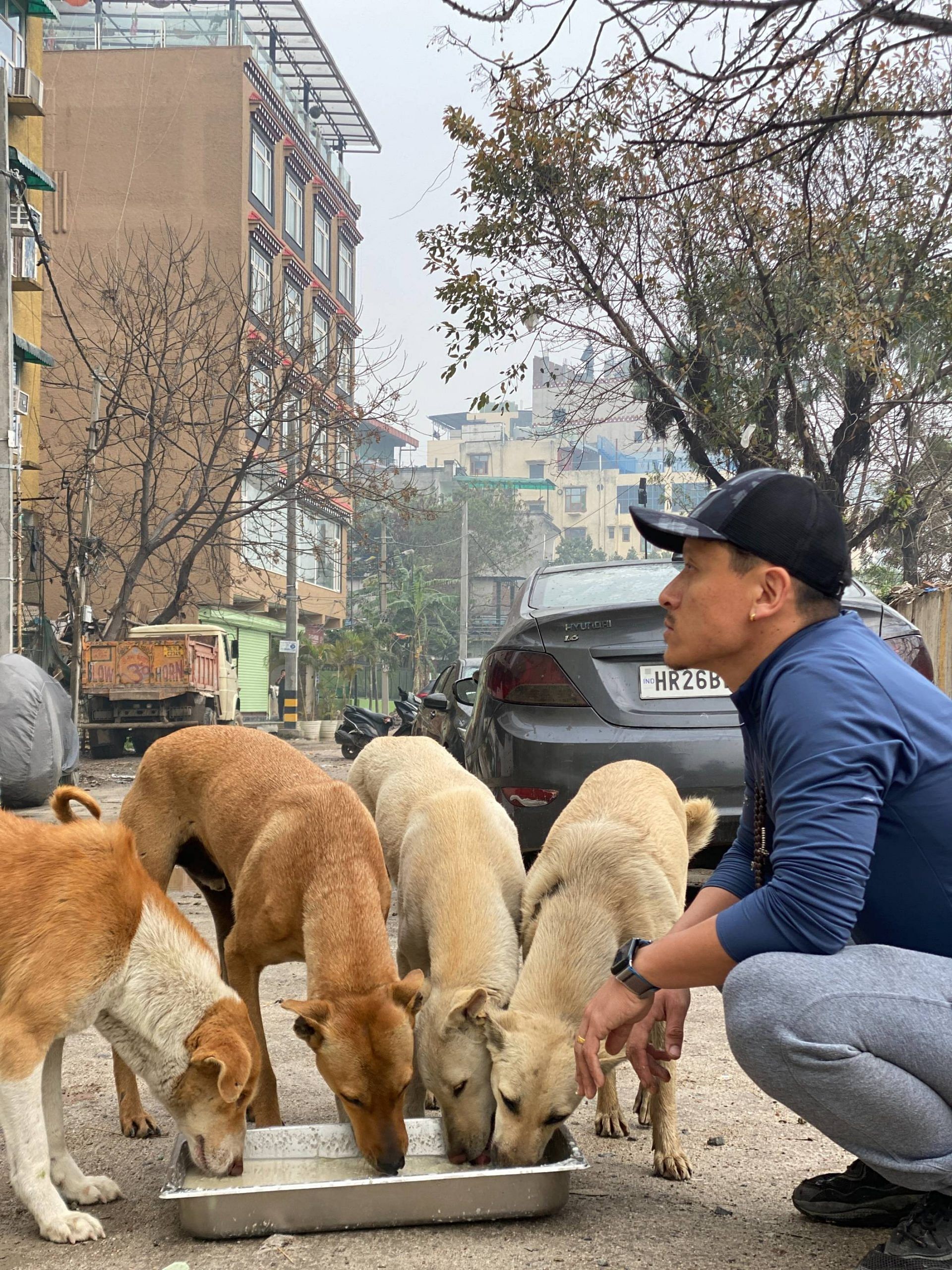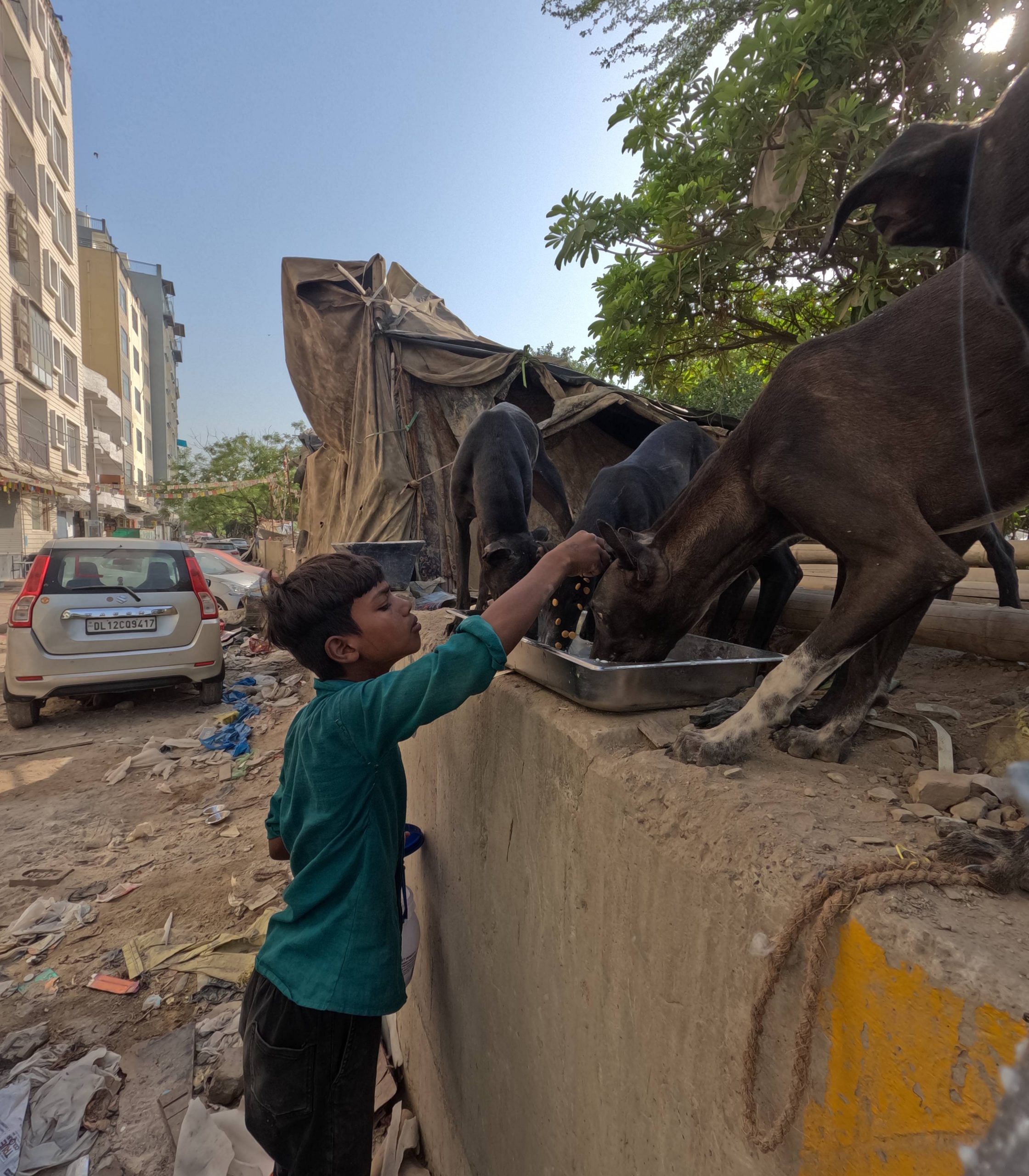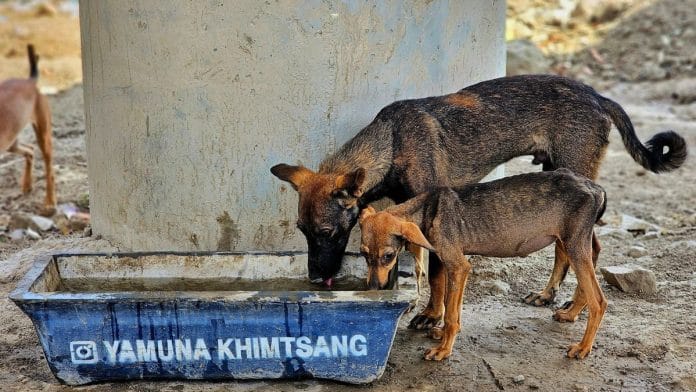New Delhi: At seven in the morning, members and volunteers of the nonprofit organisation Yamuna Khimtsang hustle to fill steel trays with a soupy mix of rice and curd for the 120 street dogs in New Delhi’s New Aruna Nagar. There’s a sense of urgency in the kitchens and on the streets—all the dogs have to be fed before the scorching Delhi sun starts blazing. By 9 am, everyone retreats – people to their homes and shanties, and the dogs to anywhere they can find some shade.
A spell of rain on Friday offered people and animals a measure of relief from the extreme and prolonged heat waves this summer. But the record-breaking scorching heat has humans and animals more susceptible to heat stress, exhaustion, and even stroke.
Animal caregivers are stunned by the spike in heatstroke cases suffered by stray dogs this year – creatures they trust to bear harsh weather conditions.
“We started working five years ago and this is the first time we are seeing so many cases of heatstroke. In the last 25 days, five of the dogs we feed have died due to the heat,” said Shubhankar Singh, whose NGO, Ojaswini, feeds nearly 700 stray dogs in Delhi.

The extreme temperatures have also caused some of the animal groups to halt crucial programmes like sterilisation and vaccination.
Rising heat strokes, behavioural changes
Along a stretch of Yamuna flood plains in North Delhi, at Majnu ka Tilla, the NGO Yamuna Khimtsang has laid out 150 big concrete water bowls for the area’s stray dogs.
“The dogs become more lethargic during summers. If it gets too hot, they won’t come out to eat. But more than food, we need to ensure they get water to drink. That’s also not always easy to ensure,” said Kungsang Tsephel, co-founder of Yamuna Khimtsang.
But lethargy is not the only behavioural change animal welfare groups have observed. With rising temperatures, once good-natured dogs have become irritable. The friendly dogs don’t want to play or jump around.
Neighbourhood Woof, a welfare organisation in Timarpur, has been grappling with four cases of heatstroke among dogs since it was founded nearly 10 years ago. Earlier this month, it received a dog that was bleeding from the nose, had an unbelievably high temperature, and was panting.
“We brought him in, and the shade, food, and security helped him. He survived that,” said Ayesha Christina Benn, who runs the organisation. Of the four cases, two were from Delhi University. Benn attributed the situation to the concretisation of the campus, which increases the temperature and leaves little shade. She has also seen a rise in tick fever alongside heatstroke.
“I think they go and sit in mud to try and keep themselves cool. And that gives them ticks,” she added.
In Delhi’s streets and JJ clusters, humans and animals often compete for the same resources. According to Tsephel, their work involves collaborating with slum residents to ensure the water bowls are not stolen and are regularly refilled.

“Dogs can manage everything; they just need some resources. We need to ensure those things are available to them so that they don’t need to go far in search of them,” Tsephel added.
Also read:
Water dishes, coolers for animals
The heatwave hasn’t spared cats or abandoned cattle either. Karishma Gaur, a volunteer at the Noida Animal Shelter in Sector-94, which is managed by All Creatures Great and Small (AGCS), looks after the cattery at the centre. It houses over 2,000 animals, including cows.
“This year, I saw them (cats) panting, which is not common for cats. That set off alarms for me,” Gaur said.
The cattery is filled with earthen pots and water dishes to help the animals hydrate and cope with the heat. They have kept larger paraats (trays) filled with water for the cats to splash around. The best addition – three new coolers exclusively for the cats. Elaborate arrangements have been made to provide water for different animals. Large water paraats have been kept across the shelter for dogs and donkeys, and there are troughs for cows.
“Wherever we can, we have put up large jute curtains that we wet all day to cool the air ventilating into the various sections for natural cooling,” Gaur said.
Switching up the food is another tactic these animal welfare groups resort to. Both Yamuna Khimtsang and Neighbourhood Woof have switched to curd from milk. Non-vegetarian food and milk were completely cut off the moment the mercury soared because these foods affect body heat and upset animals’ stomachs.
Benn has also noticed a severe drop in vitamin levels in dogs during summer. “We need a few more years to see if it’s because of the heat specifically.”
Also read: Urbanisation behind 60% of warming trend in Indian cities, tier-2 towns in the east worst-affected
Sterilisation drives suffer setback
The dogs of Majnu Ka Tilla are fed once a day. Tsephel said the quantity is enough to satisfy their hunger and keep them healthy. They have been able to deliver on this task ceaselessly because half of their dog population is sterilised, a feat achieved in collaboration with Neighbourhood Woof. However, these institutional efforts –regular neutering and vaccination – become difficult during heatwaves. Anupriya Dalmia, founder of Dogs (& Cats) of Delhi, detailed the heatwave’s severe impact on their sterilisation programmes.
“Normally, we do a large number of sterilisations daily. We have between 15 to 30 sterilisations happening daily for dogs. But due to the heat, we’ve had to almost put a complete pause to our programme because it’s just way too hot for the dogs to actually sit in that van, travel, get surgery,” she explained.
Timely execution of sterilisation drives is essential to keep the stray dog population under check and prevent rabies outbreaks.
The Delhi municipality has empanelled Neighbourhood Woof to carry out sterilisation and vaccination of street animals. Thankfully, it has managed to wade through the crisis.
“We go catching and releasing in the morning and late in the evening to keep the dogs cool. We wet the car and the dogs to cool them down and ensure our vehicle air conditioner is serviced and working well,” Benn said.
The unprecedented summer has not only disrupted sterilisations but has also made other crucial activities – feeding and vaccinations – extremely challenging. As night and morning temperatures remain high, Dalmia’s initiative to feed stray animals has also been impacted, no matter how early they start in the day. Despite these difficulties, the organisation has managed to maintain its feeding programmes.
“Feeding can’t stop. There’s not been a single day where we’ve not done the feeding. But everything else has had to become a lot slower,” she said.
Also read:
‘Select few can’t handle the burden’
All animal welfare workers underscored the need for community involvement to tackle these challenges. Dalmia, who runs another initiative, Paws for a Cause, distributed 150 water bowls to animal caregivers across Delhi.
Simple practices like keeping water bowls on terraces for birds and monkeys or allowing stray dogs to nap in shady verandahs during the day are effortless yet essential actions.
“All of these things matter. It’s very hard for a select few of the community to handle the burden that exists. Everybody needs to get involved,” said Benn.
The animal welfare groups are also focusing on equipping shelters and centres with necessary resources – coolers, ACs and water access – to handle surgery or treatments during summer months. The ongoing water shortage in Delhi has further complicated their work. And they are forever in need of funds. This summer, Benn’s electricity bills for the shelter touched Rs 60,000. A week ago, on the Instagram page of Neighbourhood Woof, she made a desperate appeal for industrial-sized coolers and water coolers. Nearly 30 dogs had huddled up in front of a tiny air cooler at the shelter, their coats sprayed with water to cool them down.
“We don’t have any kind of large government funding. So, we can’t possibly just keep paying for these things. These things have to become community-led, which is what’s not happening,” said Dalmia.
(Edited by Zoya Bhatti)






